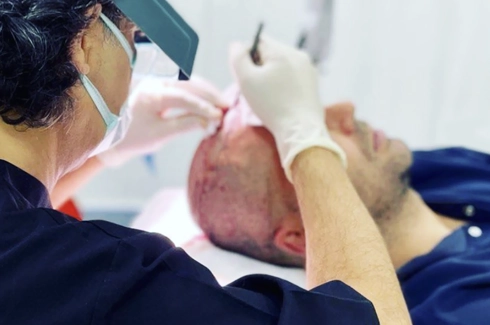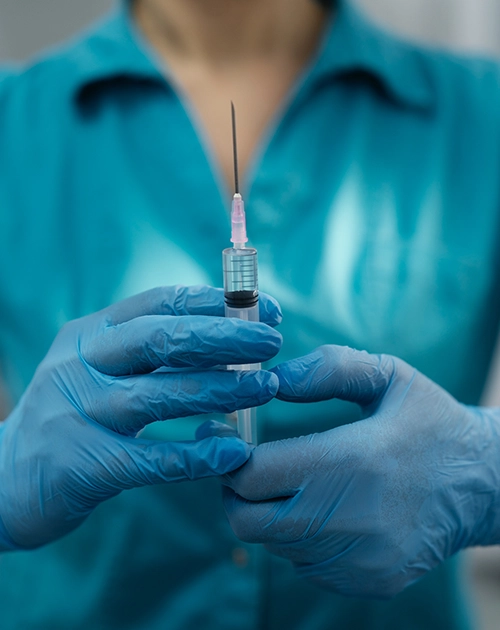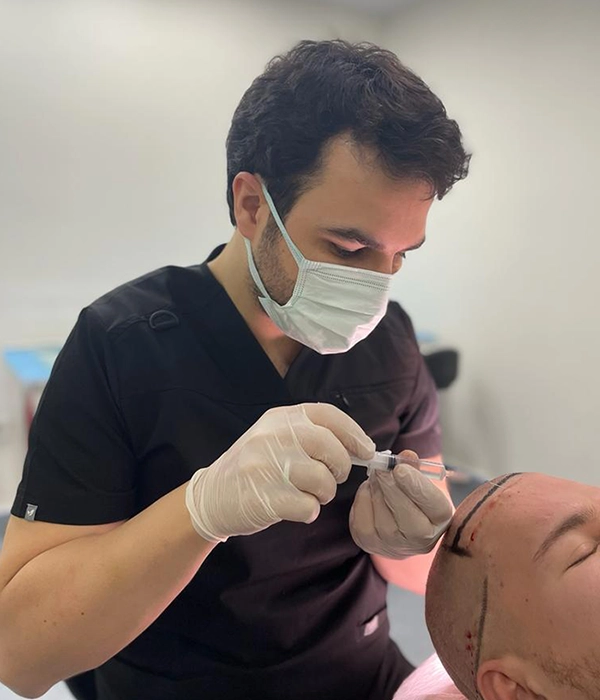

Hair transplantation is a surgical procedure that involves transferring hair follicles from a donor area, typically the back or sides of the scalp, to the balding or thinning areas.
This procedure is primarily sought after by patients experiencing hair loss due to genetic factors, hormonal changes, or other medical conditions. By relocating healthy hair follicles to areas of hair loss, hair transplantation can effectively restore natural-looking hair growth and improve overall appearance and self-confidence.
The hair transplant process involves several key steps to achieve successful results. When each step of the hair transplantation is executed with precision and expertise, it leads to natural-looking results that blend seamlessly with the patient's existing hair.
Many patients considering hair transplant procedures often wonder about the level of pain involved. While discomfort can vary depending on each patient’s pain tolerance and the specific techniques used, modern hair transplant procedures are generally well-tolerated and associated with minimal pain or discomfort.
Local anesthesia is administered to numb the scalp during the procedure, ensuring that patients remain comfortable throughout. Additionally, advancements in surgical techniques, such as Follicular Unit Extraction (FUE), have significantly reduced post-operative pain and recovery time compared to older methods. Some patients may experience mild soreness or discomfort in the donor and recipient areas following the procedure, but this can typically be managed with over-the-counter pain medication prescribed by the surgeon.
Overall, while discomfort during and after the procedure is possible, many patients find that the benefits of hair transplantation far outweigh any temporary discomfort experienced.
Hair transplant procedures typically involve minimal pain or discomfort due to the administration of local anesthesia, which numbs the scalp during the surgery. Patients may feel slight pressure or pulling sensations, but these are generally well-tolerated. After the procedure, mild soreness or discomfort in the donor and recipient areas is common, similar to a mild sunburn sensation, and can be managed with over-the-counter pain medication. Overall, while some discomfort may be experienced, the pain associated with a hair transplant procedure is generally minimal.
Reducing pain during a hair transplant procedure is a priority for both patients and surgeons. Here are several strategies commonly employed to minimize discomfort:

During hair transplantation procedures, local anesthesia is predominantly used to ensure patient comfort. Local anesthesia involves the administration of medication directly to the scalp, numbing the area where the surgery will be performed. This anesthesia is typically administered via injections and effectively blocks pain signals from reaching the brain, allowing patients to remain awake and alert during the procedure while experiencing minimal discomfort.
In some cases, patients may also receive additional sedation or oral medications to help them relax during the procedure, although general anesthesia is rarely necessary for hair transplantation. The use of local anesthesia allows for a smoother surgical experience and facilitates quicker recovery times for patients undergoing hair transplantation.
Local anesthesia injections used during hair transplant procedures are designed to minimize discomfort for patients, but some patients may still experience mild sensations during the administration process. The injections typically involve a small needle being inserted into the scalp to deliver the anesthesia. While the initial prick may cause a brief sensation similar to a mild pinch or sting, any discomfort is usually minimal and short-lived.
It's worth noting that while the first few injections might be slighly uncomfortable, once the anesthesia takes effect, the procedure becomes pain-free. Overall, local anesthesia injections for hair transplant may cause minor discomfort initially but are generally well-tolerated by most patients and play a crucial role in ensuring a comfortable surgical experience.
General anesthesia is typically not needed for hair transplantation procedures. Hair transplant surgeries are commonly performed under local anesthesia, which i allows patients to remain awake and alert throughout the surgery while ensuring they experience minimal pain or discomfort. This approach not only reduces the risks associated with general anesthesia but also allows for a quicker recovery and a shorter hospital stay.
However, in some cases where patients have significant anxiety or medical conditions that may necessitate general anesthesia, it is essential to discuss these concerns with the surgeon beforehand to determine the most appropriate anesthesia approach for the individual patient.
Pain during a hair transplant procedure may occur due to various factors, including inadequate anesthesia or discomfort during anesthesia injection. While local anesthesia effectively numbs the scalp to minimize pain, some patients may experience sensations during the injection process. The needles used for anesthesia injection may cause discomfort when inserted into the skin or when the anesthesia drug is injected, often due to the pressure created by the drug.
To reduce the pain associated with the initial injections during a hair transplant procedure, several factors can be implemented to enhance patient comfort such as utilizing thin needles with smaller diameters to help minimize the discomfort caused by the initial insertion into the skin. Mixing anesthetic agents with a carbonate buffer can help reduce the acidic pH of the solution, making it less irritating and more comfortable for the patient during injection. Using a vibrating device or tool during the injection process can help distract the patient's attention from the sensation of pain.
Additionally, patients with a lower pain threshold or heightened sensitivity may perceive these sensations differently. Communication with the surgical team regarding any discomfort allows adjustments to be made to enhance patient comfort. While pain during a hair transplant procedure is typically minimal, addressing any concerns regarding anesthesia administration can help ensure a more comfortable surgical experience for patients.
Hair transplant recovery is generally not painful, but patients may experience some discomfort or mild pain during the healing process. After the procedure, patients may feel some soreness, tightness, or swelling in the donor and recipient areas of the scalp. Factors such as the use of large punches during graft removal, excessive trauma, or merging of holes may slightly increase pain during the healing process. This discomfort is typically manageable with over-the-counter pain medication prescribed by the surgeon.
Additionally, some patients may experience itching or numbness in the treated areas as the scalp heals. These sensations are normal and usually subside within a few days to a few weeks post-surgery. It's essential for patients to follow post-operative care instructions provided by their surgeon to promote proper healing and minimize discomfort. While discomfort during hair transplant recovery is common, severe pain or unusual symptoms should be promptly reported to the surgeon for further evaluation and management.
Managing pain after a hair transplant is essential for a comfortable and smooth recovery process. Here are some tips to help alleviate discomfort and promote healing:
The duration for post-hair transplant pain to diminish varies among patients. Typically, patients may experience some discomfort or soreness in the donor and recipient areas immediately after the procedure. However, this discomfort gradually subsides over time. In most cases, patients report a significant reduction in pain within the first week following the surgery. By the end of the second week, many patients experience minimal to no pain, although some residual soreness or sensitivity may persist for a few weeks.
At Civas Hair Transplant Turkey, we emphasize the importance of avoiding general anesthesia or sedation, a recommendation endorsed by Dr. Civas and Dr. Akpınar, esteemed professionals in the hair transplantation field. We believe that a good anesthesia protocol should never involve sedation administered intravenously or any additional incoming anesthesia.
While general anesthesia may seem like a viable option for some, it carries various risks that we believe are unnecessary for hair transplant procedures At Civas Hair Transplant, your hair surgeon manages the entire anesthesia process diligently and comprehensively, ensuring your safety and comfort throughout. We opt for advanced local anesthesia techniques, ensuring that patients remain awake and alert throughout the procedure while experiencing minimal discomfort.

At Civas Hair Transplant in Turkey, we prioritize patient comfort and safety by employing advanced anesthesia techniques tailored to each patient’s needs. During the procedure, both nerve block and infiltration anesthesia are utilized to ensure optimal pain management. Thanks to the unique anesthesia administration method developed by Dr. Civas specifically for this procedure, our surgeries are performed with minimal discomfort for our patients.
Dr. Ümit Akpınar, one of our esteemed dermatologists, specializes in anesthesia administration and will ensure that you are at ease before the surgical process begins. Local anesthesia is administered to both the donor and recipient areas, ensuring complete numbness throughout the surgery and alleviating any potential discomfort.
We understand that anesthesia can be a concern for some patients, which is why we take the time to address any questions or concerns you may have during this phase. Clear communication with your surgeon during the procedure is essential to ensure that the anesthesia is adjusted appropriately, minimizing any discomfort or pain you may experience.
Once the effect of anesthesia wears off after the surgery, our patients typically do not experience significant pain, and any discomfort can be effectively managed with prescribed pain medication and supportive care. We prioritize ongoing communication and follow-up care to address any concerns and ensure our patients' comfort and satisfaction throughout their hair transplant journey at Civas Hair Transplant.
If you're ready to embark on your hair transplant journey and wish to explore and discuss your pain management options, don't hesitate to contact Civas Hair Transplant. Fill out the consultation form below to take the first step towards a confident and comfortable hair restoration experience.
I visited Dr Civas’ Hair Transplangt Center twice; first time in 2021 and recently in February 2023. I was referred to the clinic by a friend who had a great experience a{...}
12.08.2023I have just had a hair transplant and am amazed by the professionalism and super service, from the first contact to the operation and following checkups. Everyone has bee{...}
07.09.2023The trip to Ankara and the clinic was great. The clinic staff was friendly and took good care of me throughout the trip. A little over a year has passed since the operati{...}
07.09.2023